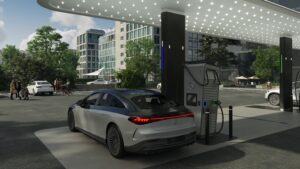
Mercedes to launch first ‘high-power’ charging stations, Stellantis expands focus on dealer EV-readiness
By onAnnouncements
Mercedes-Benz and Stellantis have announced their respective plans to expand their electric vehicle (EV) charging networks across the U.S., including the installation of Mercedes’ first high-power charging stations.
Beginning in October, the first Mercedes-Benz Charging Hubs will go into operation in Atlanta, Georgia; Chengdu, China, and Mannheim, Germany. By the end of 2024, the automaker plans to expand its global charging network to more than 2,000 high-power charging points.
The long-term goal is to create more than 2,000 Charging Hubs with more than 10,000 charging points by the end of the decade.
Depending on region, the charging stations offer charging rates up to 400 kilowatts (kW) provided via Combined Charging Standard Combo 1 (CCS1), Combined Charging Standard Combo 2 (CCS2), North American Charging Standard (NACS), and China’s GB/T standard. Each vehicle can be charged at its maximum power rating, which Mercedes says reduces charging time for customers to “an absolute minimum.”
The charging stations are located at main traffic areas and select Mercedes dealerships along with amenities for users including drinks, snacks, and restrooms as well as surveillance cameras for safety.
While open to all EV brands, Mercedes customers will be able to reserve a charging point via the Mercedes-Benz me Charge service. The network stations will also offer automated payment and will be integrated into route planning through Mercedes’ Navigation with Electric Intelligence feature.
“We firmly believe that electric mobility is the key to a sustainable, zero-emission future. Our goal is to create an infrastructure that offers electric vehicles reliable and easy charging options,” said Franz Reiner, Mercedes-Benz Mobility AG CEO. “In this way, we are actively supporting the transformation to electric mobility With the Mercedes-Benz High-Power Charging Network, we are expanding global charging options and setting new standards in electric vehicle charging. We want to encourage our customers to switch to zero-emission vehicles and thus make a positive contribution to protecting our environment.”
Mercedes says the network will be powered by 100% renewable energy based on its “Ambition 2039” plan, which the OEM says is “a holistic approach to climate protection and air pollution control.”
In July, Mercedes joined several other automakers to expand its charging options to NACS, also known as Tesla’s charging standard, so drivers can use Tesla Superchargers in North America via an adaptor, beginning in 2025.
Efforts by Stellantis entail a partnership with Charge Enterprises to expand its U.S. dealership charging network. It is the OEM’s fourth recommended partner for Stellantis dealer EV readiness joining Future Energy, Vehya, and — most recently — AGI, which will provide electrical engineering, project management, fabrication, and maintenance capabilities.
In a joint news release, Stellantis and Charge said Charge’s client education, project management, design, engineering, and installation will provide a full-service solution for dealers.
“All of the dealers we work with value our dedicated approach and our thoughtful mindset to delivering solutions today while preparing our clients for the EV infrastructure demands of tomorrow,” said Mark LaNeve, president of Charge. “We remain committed to helping as many auto dealers throughout the country execute on much-needed EV charging infrastructure as we remain focused on meeting the needs of the Stellantis dealer body, who are doing a great job meeting the needs of their customers.”
As part of its Dare Forward 2030 plan, Stellantis is aiming for 50% of U.S. sales to be battery electric vehicles (BEVs) by the end of this decade. The company plans to offer more than 25 BEVs in the U.S. by 2030.
Images
Featured image: Mercedes-Benz says it will open its first high-power charging stations worldwide this fall. (Credit: Mercedes-Benz)
